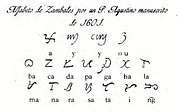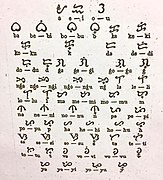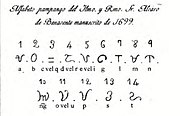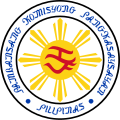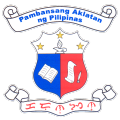Baybayin
| Baybayin Sulat Tagalog | |
|---|---|
"Tagalog script" ("Sulat Tagalog") written using traditional rules, also maintaining syllable-character count correspondence | |
| Script type | |
Time period | 14th to 19th century[1][2][3] limited modern usage[4] |
| Direction | Left-to-right |
| Languages | Tagalog, Bisayan languages,[5] Sambali, Ilocano, Kapampangan, Bikol, Pangasinan |
| Related scripts | |
Parent systems | |
Child systems | |
Sister systems | |
| ISO 15924 | |
| ISO 15924 | Tglg (370), Tagalog (Baybayin, Alibata) |
| Unicode | |
Unicode alias | Tagalog |
| U+1700–U+171F | |
| Brahmic scripts |
|---|
| The Brahmi script and its descendants |
Baybayin (,[a] Tagalog pronunciation: [bajˈbajɪn]) or Sulat Tagalog, also called Basahan by Bicolanos, sometimes erroneously referred to as alibata, is a Philippine script widely used primarily in Luzon during the 16th and 17th centuries and prior to write Tagalog and to a lesser extent Visayan languages, Kampampangan, Ilocano, and several other Philippine languages.
Baybayin is an abugida belonging to the family of the Brahmic scripts. Its use was gradually replaced by the Latin alphabet during Spanish rule, though it has seen limited modern usage in the Philippines. The script is encoded in Unicode as Tagalog block since 1998 alongside Buhid, Hanunoo, and Tagbanwa scripts.[6] The Archives of the University of Santo Tomas in Manila holds the largest collection of extant writings using Baybayin.[7][8][9]
Baybayin has seen increasing modern usage in the Philippines. Today, Baybayin is often used for cultural and aesthetic purposes, such as in art, graduation regalia, tattoos, and logos. It is also featured on the logos of government agencies, Philippine banknotes, and passports. Additionally, there are educational initiatives and workshops aimed at teaching Baybayin to a new generation. Social media has also been instrumental in the increased awareness and interest in Baybayin. Artists, educators, and enthusiasts use these platforms to share tutorials, artworks, and historical facts about the script, sparking interest among younger generations.[10][11][12] Bills to recognize the script and revive its use alongside the Latin alphabet have been repeatedly considered by the Congress.[13]
Terminology
[edit]The term baybáyin means "to write" or "to spell" in Tagalog. The earliest known use of the word to refer to the script was from the Vocabulario de la lengua tagala (1613) by Pedro San Buenaventura as baibayin.[14]
Baybayin is also used colloquially as an umbrella term for the indigenous scripts in the Philippines. However, this has since been discouraged by linguists, who prefer to use the term suyat to refer to these pre-Hispanic scripts as a whole.[15]
Historically, the term alibata was used synonymously with Baybayin.[16][17] Alibata is a neologism first coined in 1914, possibly under the false assumption that the script was derived from the Arabic script, hence the name.[18] Most modern scholars reject the use of the word alibata as incorrect.[18][19]
Origins
[edit]The origins of baybayin are disputed and multiple theories exist as to its origin.
Influence of Greater India
[edit]
Historically Southeast Asia was under the influence of Ancient India, where numerous Indianized principalities and empires flourished for several centuries in Thailand, Indonesia, Malaysia, Singapore, Philippines, Cambodia and Vietnam. The influence of Indian culture into these areas was given the term Indianization.[20] French archaeologist George Coedes defined it as the expansion of an organized culture that was framed upon Indian originations of royalty, Hinduism and Buddhism and the Sanskrit language.[21] This can be seen in the Indianization of Southeast Asia, Hinduism in Southeast Asia and the spread of Buddhism in Southeast Asia. Indian honorifics also influenced the Malay, Thai, Filipino and Indonesian honorifics.[22] Examples of these include raja, rani, maharlika, and datu, which were transmitted from Indian culture to Philippines via Malays and the Srivijaya empire.[citation needed] Indian Hindu colonists played a key role as professionals, traders, priests and warriors.[23][24][25][26] Inscriptions have proved that the earliest Indian colonists who settled in Champa and the Malay Archipelago, came from the Pallava dynasty, as they brought with them their Pallava script. The earliest inscriptions in Java exactly match the Pallava script.[23] In the first stage of adoption of Indian scripts, inscriptions were made locally in Indian languages. In the second stage, the scripts were used to write the local Southeast Asian languages. In the third stage, local varieties of the scripts were developed. By the 8th century, the scripts had diverged and separated into regional scripts.[27]
Isaac Taylor sought to show that baybayin was introduced into the Philippines from the Coast of Bengal sometime before the 8th century. In attempting to show such a relationship, Taylor presented graphic representations of Kistna and Assam letters like g, k, ng, t, m, h, and u, which resemble the same letters in baybayin. Fletcher Gardner argued that the Philippine scripts have "very great similarity" with the Brahmi script,[28] which was supported by T. H. Pardo de Tavera. According to Christopher Miller, evidence seems strong for baybayin to be ultimately of Gujarati origin; however, Philippine and Gujarati languages have final consonants, so it is unlikely that their indication would have been dropped had baybayin been based directly on a Gujarati model.[29]
Kawi
[edit]
The Kawi script originated in Java, descending from the Pallava script,[30] and was used across much of Maritime Southeast Asia. The Laguna Copperplate Inscription is the earliest known written document found in the Philippines. It is a legal document with the inscribed date of Saka era 822, corresponding to 21 April 900 AD. It was written in the Kawi script in a variety of Old Malay containing numerous loanwords from Sanskrit and a few non-Malay vocabulary elements whose origin is ambiguous between Old Javanese and Old Tagalog. A second example of Kawi script can be seen on the Butuan Ivory Seal, found in the 1970s and dated between the 9th and 12th century. It is an ancient seal made of ivory that was found in an archaeological site in Butuan. The seal has been declared as a national cultural treasure. The seal is inscribed with the word Butwan in stylized Kawi. The ivory seal is now housed at the National Museum of the Philippines.[31] One hypothesis therefore reasons that, since Kawi is the earliest attestation of writing in the Philippines, then baybayin may have descended from Kawi.
South Sulawesi scripts
[edit]David Diringer, accepting the view that the scripts of the Malay Archipelago originate in India, writes that the South Sulawesi scripts derive from the Kawi script, probably through the medium of the Batak script of Sumatra. The Philippine scripts, according to Diringer, were possibly brought to the Philippines through the Buginese characters in Sulawesi.[32] According to Scott, baybayin's immediate ancestor was very likely a South Sulawesi script, probably Old Makassar or a close ancestor.[33] This is because of the lack of final consonants or vowel canceler markers in baybayin. South Sulawesi languages have a restricted inventory of syllable-final consonants and do not represent them in the Bugis and Makassar scripts. The most likely explanation for the absence of final consonant markers in baybayin is therefore that its direct ancestor was a South Sulawesi script. Sulawesi lies directly to the south of the Philippines and there is evidence of trade routes between the two. Baybayin must therefore have been developed in the Philippines in the fifteenth century CE as the Bugis-Makassar script was developed in South Sulawesi no earlier than 1400 CE.[34]
Cham script
[edit]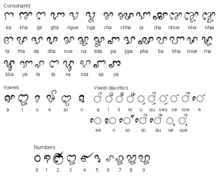
Baybayin could have been introduced to the Philippines by maritime connections with the Champa Kingdom. Geoff Wade has argued that the baybayin characters "ga", "nga", "pa", "ma", "ya" and "sa" display characteristics that can be best explained by linking them to the Cham script, rather than other Indic abugidas. According to Wade, Baybayin seems to be more related to other southeast Asian scripts than to Kawi script. Wade argues that the Laguna Copperplate Inscription is not definitive proof for a Kawi origin of baybayin, as the inscription displays final consonants, which baybayin does not.[35]
History
[edit]From the material that is available, it is clear that baybayin was used in Luzon, Palawan, Mindoro, Pangasinan, Ilocos, Panay, Leyte and Iloilo, but there is no proof supporting that baybayin reached Mindanao. It appears that the Luzon and Palawan varieties started to develop in different ways in the 1500s, before the Spaniards conquered what we know today as the Philippines. This puts Luzon and Palawan as the oldest regions where baybayin was and is used. It is also notable that the script used in Pampanga had already developed special shapes for four letters by the early 1600s, different from the ones used elsewhere. There were three somewhat distinct varieties of baybayin in the late 1500s and 1600s, though they could not be described as three different scripts any more than the different styles of Latin script across medieval or modern Europe with their slightly different sets of letters and spelling systems.[5]
-
Tagalog baybayin
-
Sambal variety, used for the Sambal language of Zambales
-
Kuritan variety, from Ilocos
-
Ancient Characters of Tagalog and Camarines People, also called Basahan in Bicol region
-
Pangasinan language variety
-
Badlit variety from Visayas
-
Kapampangan variety from Pampanga
Early history
[edit]An earthenware burial jar, called the "Calatagan Pot," found in Batangas is inscribed with characters strikingly similar to baybayin, and is claimed to have been inscribed ca. 1300 AD. However, its authenticity has not yet been proven.[1][36]
Although one of Ferdinand Magellan's shipmates, Antonio Pigafetta, wrote that the people of the Visayas were not literate in 1521, the baybayin had already arrived there by 1567 when Miguel López de Legazpi reported from Cebu that, "They [the Visayans] have their letters and characters like those of the Malays, from whom they learned them; they write them on bamboo bark and palm leaves with a pointed tool, but never is any ancient writing found among them nor word of their origin and arrival in these islands, their customs and rites being preserved by traditions handed down from father to son without any other record."[37] A century later, in 1668, Francisco Alcina wrote: "The characters of these natives [Visayans], or, better said, those that have been in use for a few years in these parts, an art which was communicated to them from the Tagalogs, and the latter learned it from the Borneans who came from the great island of Borneo to Manila, with whom they have considerable traffic... From these Borneans the Tagalogs learned their characters, and from them the Visayans, so they call them Moro characters or letters because the Moros taught them... [the Visayans] learned [the Moros'] letters, which many use today, and the women much more than the men, which they write and read more readily than the latter."[18] Francisco de Santa Inés explained in 1676 why writing baybayin was more common among women, as "they do not have any other way to while away the time, for it is not customary for little girls to go to school as boys do, they make better use of their characters than men, and they use them in things of devotion, and in other things that are not of devotion."[38]
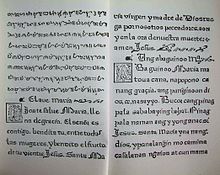
The earliest printed book in a Philippine language, featuring both Tagalog in baybayin and transliterated into the Latin script, is the 1593 Doctrina Christiana en Lengua Española y Tagala. The Tagalog text was based mainly on a manuscript written by Fr. Juan de Placencia. Friars Domingo de Nieva and Juan de San Pedro Martyr supervised the preparation and printing of the book, which was carried out by an unnamed Chinese artisan. This is the earliest example of baybayin that exists today and it is the only example from the 1500s. There is also a series of legal documents containing baybayin, preserved in Spanish and Philippine archives that span more than a century: the three oldest, all in the Archivo General de Indias in Seville, are from 1591 and 1599.[39][5]
Baybayin was noted by the Spanish priest Pedro Chirino in 1604 and Antonio de Morga in 1609 to be known by most Filipinos, and was generally used for personal writings and poetry, among others. However, according to William Henry Scott, there were some datus from the 1590s who could not sign affidavits or oaths, and witnesses who could not sign land deeds in the 1620s.[40]
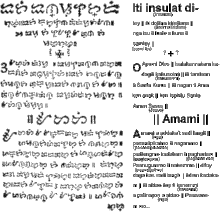
In 1620, Libro a naisurátan amin ti bagás ti Doctrina Cristiana was written by Fr. Francisco Lopez, an Ilocano Doctrina the first Ilocano baybayin, based on the catechism written by Cardinal Bellarmine.[41] This is an important moment in the history of baybayin, because the krus-kudlít was introduced for the first time, which allowed writing final consonants. He commented the following on his decision:[18] "The reason for putting the text of the Doctrina in Tagalog type... has been to begin the correction of the said Tagalog script, which, as it is, is so defective and confused (because of not having any method until now for expressing final consonants - I mean, those without vowels) that the most learned reader has to stop and ponder over many words to decide on the pronunciation which the writer intended." This krus-kudlít, or virama kudlít, did not catch on among baybayin users, however. Native baybayin experts were consulted about the new invention and were asked to adopt it and use it in all their writings. After praising the invention and showing gratitude for it, they decided that it could not be accepted into their writing because "It went against the intrinsic properties and nature that God had given their writing and that to use it was tantamount to destroy with one blow all the Syntax, Prosody and Orthography of their Tagalog language."[43]
In 1703, baybayin was reported to still be in use in the Comintan (Batangas and Laguna) and other areas of the Philippines.[44]
Among the earliest literature on the orthography of Visayan languages were those of Jesuit priest Ezguerra with his Arte de la lengua bisaya in 1747[45] and of Mentrida with his Arte de la lengua bisaya: Iliguaina de la isla de Panay in 1818 which primarily discussed grammatical structure.[46] Based on the differing sources spanning centuries, the documented syllabaries also differed in form. [clarification needed]
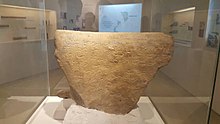
The Ticao stone inscription, also known as the Monreal stone or Rizal stone, is a limestone tablet that contains baybayin characters. Found by pupils of Rizal Elementary School on Ticao Island in Monreal town, Masbate, which had scraped the mud off their shoes and slippers on two irregular shaped limestone tablets before entering their classroom, they are now housed at a section of the National Museum of the Philippines, which weighs 30 kilos, is 11 centimeters thick, 54 cm long and 44 cm wide while the other is 6 cm thick, 20 cm long and 18 cm wide.[47][48]
Usage
[edit]
Historically, baybayin was used in Tagalog- and to a lesser extent Kapampangan-speaking areas. It spread to the Ilocanos when the Spanish distributed bibles written in baybayin. Pedro Chirino, a Spanish priest and Antonio de Morga noted in 1604 and 1609 that most Filipino men and women could read baybayin.[35] It was also noted that they did not write books or keep records, but did use baybayin for signing documents, for personal notes and messages, and for poetry.[40] During the colonial period, Filipinos began keeping paper records of their property and financial transactions, and would write down lessons they were taught in church.[18] Documents written in the native language and began to play a significant role in the judicial and legal life of the colony.[49]
Traditionally, baybayin was written upon palm leaves with a sharp stylus or on bamboo with a small knife.[50] The curved shape of the letter forms of baybayin is influenced by this practice; curved lines straight lines would have torn the leaves.[51] Once the letters were carved into the bamboo, it was wiped with ash to make the characters stand out.[18]
During the era of Spanish colonization, baybayin came to be written with ink on paper using a sharpened quill.[52] Woodblock printed books were produced to facilitate the spread of Christianity.[53] In some parts of the country, such as Mindoro the traditional writing technique has been retained.[54]
Decline
[edit]Baybayin fell out of use in much of the Philippines under Spanish rule. Learning the Latin alphabet also helped Filipinos to make socioeconomic progress, as they could rise to relatively prestigious positions such as clerks, scribes and secretaries.[18] In 1745, Sebastián de Totanés wrote in his Arte de la lengua tagala that "The Indian [Filipino] who knows how to read baybayin is now rare, and rarer still is one who knows how to write [it]. They now all read and write in our Castilian [ie Latin] letters."[4] Between 1751 and 1754, Juan José Delgado wrote that "the [native] men devoted themselves to the use of our [Latin] writing".[55] The ambiguity of vowels i/e and o/u, the lack of syllable-final consonants and of letters for some Spanish sounds may also have contributed to the decline of baybayin.
The rarity of pre-Hispanic baybayin texts has led to a common misconception that fanatical Spanish priests must have destroyed the majority native documents. Anthropologist and historian H. Otley Beyer wrote in The Philippines before Magellan (1921) that, "one Spanish priest in Southern Luzon boasted of having destroyed more than three hundred scrolls written in the native character". In fact, historians have been unable to verify Beyer's claim,[18] and there is no direct evidence of substantial destruction of documents by Spanish missionaries.[56] Hector Santos has suggested although that Spanish friars may have occasionally burned short documents such as incantations, curses and spells (deemed evil by the church) but rejected the idea that there was any systematic destruction of pre-Hispanic manuscripts.[57] Morrow also notes that there are no recorded instances of pre-Hispanic Filipinos writing on scrolls, and that the most likely reason why no pre-Hispanic documents survived is because they wrote on perishable materials such as leaves and bamboo. There are also no reports of Tagalog written scriptures, as the Filipinos kept their theological knowledge in oral form while using the Baybayin for secular purposes and talismans.[58]
The scholar Isaac Donoso claims that the documents written in the native language and in native scripts played a significant role in the judicial and legal life of the colony and noted that many colonial-era documents written in baybayin still exist in some repositories, including the library of the University of Santo Tomas.[49] He also noted that the early Spanish missionaries did not suppress the usage of the baybayin script but instead may have even promoted it as a measure to stop Islamization, since the Tagalog language was moving from baybayin to Jawi, the Arabized script of Islamized Southeast Asian societies.[59] Paul Morrow also suggests that Spanish friars helped to preserve baybayin by continuing its use even after it had been abandoned by most Filipinos.[18]
Characteristics
[edit]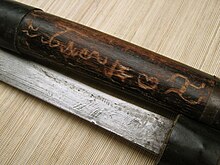
Baybayin is an abugida (alphasyllabary), which means that it makes use of consonant-vowel combinations. Each character or titik,[60] written in its basic form, is a consonant ending with the vowel /a/. To produce consonants ending with other vowel sounds, a mark called a kudlít[60] is placed either above the character to change the /a/ to an /e/ or /i/, or below for an /o/ or /u/. To write words beginning with a vowel, one of the three independent vowels (a, i/e, o/u). A third kudlít, ⟨⟩, called a sabat or krus, a virama removes a consonant's inherent a vowel, making it an independent consonant. The krus-kudlít virama was added to the original script by the Spanish priest Francisco Lopez in 1620. Later, the pamudpod virama ⟨⟩, which has the same function, was added. Beside these phonetic considerations, the script is monocameral and does not use letter case for distinguishing proper names or words starting sentences.
a
|
i or e
|
o or u
|
||
i or e
|
o or u
|
krus-kudlít
|
pamudpod
| |
ba, va
|
ka
|
da, ra
|
ga
|
ha
|
la
|
ma
|
na
|
nga
|
pa, fa
|
sa, za
|
ta
|
wa
|
ya
|
bi, vi
be, ve |
ki, ke
|
di, ri
de, re |
gi, ge
|
hi, he
|
li, le
|
mi, me
|
ni, ne
|
ngi, nge
|
pi, fi
pe, fe |
si, se
zi, ze |
ti, te
|
wi, we
|
yi, ye
|
bo, vo
bu, vu |
ko, ku
|
do, ro
du, ru |
go, gu
|
ho, hu
|
lo, lu
|
mo, mu
|
no, nu
|
ngo, ngu
|
po, fo
pu, fu |
so, zo
su, zu |
to, tu
|
wo, wu
|
yo, yu
|
IPA: /b/, /v/
|
IPA: /k/
|
IPA: /d/, /r/
|
IPA: /g/
|
IPA: /h/
|
IPA: /l/
|
IPA: /m/
|
IPA: /n/
|
IPA: /ŋ/
|
IPA: /p/, /f/
|
IPA: /s/, /z/
|
IPA: /t/
|
IPA: /w/
|
IPA: /j/
|
- ^ a b c d There is only one symbol or character for da or ra as they were allophones in many languages of the Philippines, where ra occurs in intervocalic positions and da elsewhere.[18] Baybayin variants such as sambal, basahan, and ibalnando have separate symbols for da and ra. Shared symbols are also used to represent both pa and fa, ba and va, and sa and za which were also allophonic.
Punctuation and spacing
[edit]Baybayin originally used only one punctuation mark (), which was called Bantasán.[60][61] Today baybayin uses two punctuation marks, the Philippine single () punctuation, acting as a comma or verse splitter in poetry, and the double punctuation (), acting as a period or end of paragraph. These punctuation marks are similar to single and double danda signs in other Indic Abugidas and may be presented vertically like Indic dandas, or slanted like forward slashes. The signs are unified across Philippines scripts and were encoded by Unicode in the Hanunóo script block.[62] Space separation of words was historically not used as words were written in a continuous flow, but is common today.[18]
Alphabetical order
[edit]In the Doctrina Christiana, the letters were ordered without any connection with other similar scripts, except sorting vowels before consonants as:
a, u/o, i/e; ha, pa, ka, sa, la, ta, na, ba, ma, ga, da/ra, ya, nga, wa.[63]
In Unicode the letters are ordered in a similar way to other Indic scripts, by phonetic class.
a, i/e, o/u; ka, ga, nga; ta, da/ra, na; pa, ba, ma; ya, ra, la, wa, sa, ha.[64]
Contemporary usage and revival
[edit]A number of legislative bills have been proposed periodically aiming to promote the writing system, among them is the "National Writing System Act" (House Bill 1022[65]/Senate Bill 433).[66]
There are attempts of modernizing Baybayin such as adding letters like R, C, V, Z, F, Q, and X that are not originally on the script in order to make writing modern Filipino words easier such as the word Zambales and other provinces and towns in the Philippines that have Spanish origins.[67]
Baybayin was used in the most current New Generation Currency series of the Philippine peso issued in the last quarter of 2010. The word used on the bills was "Pilipino" ().
It is also used in Philippine passports, specifically the latest e-passport edition issued 11 August 2009 onwards. The odd pages of pages 3–43 have "" ("Ang katuwiran ay nagpapadakila sa isang bayan"/"Righteousness exalts a nation") in reference to Proverbs 14:34.
-
Philippine passport showing the Baybayin script
-
Seal of the National Historical Commission of the Philippines, with the two Baybayin ka and pa letters in the center
-
Logo of the National Museum of the Philippines, with a Baybayin pa letter in the center, in a traditional rounded style
-
Logo of the Cultural Center of the Philippines, with three rotated occurrences of the Baybayin ka letter
-
Logo of National Commission for Culture and the Arts, with the Baybayin letter ka stylized as an eternal flame
-
The insignia of the Order of Lakandula with the name Lakandula, in the middle, read counterclockwise from the top
-
Logo of the National Living Treasures Award with the words Manlilikha ng Bayan
-
The front page of the publication "Panitik Silangan", mostly printed in Baybayin, September 1963
Derivative scripts
[edit]Bayabin's modern descendant scripts surviving modern script are the Tagbanwa script, also known as known as ibalnan by the Palawan people, who have adopted it, the Buhid script and the Hanunóo script of Mindoro. The modern Kulitan script is a unique script that employs consonant stacking and is derived from Old Kapampangan, the precolonial Indic script used to write the Kapampangan language, and reformed in recent decades.[citation needed]
Sample texts
[edit]Article one of the Universal Declaration of Human Rights
[edit]- Tagalog in Baybayin script;
- Romanized
Ang lahát ng tao'y isinilang na malayà at pantáy-pantáy sa karangalan at mga karapatán. Sila'y pinagkalooban ng katuwiran at budhî at dapat magpalagayan ang isá't isá sa diwà ng pagkákapatíran.
- English
All human beings are born free and equal in dignity and rights. They are endowed with reason and conscience and should act towards one another in a spirit of brotherhood.
Motto of the Philippines
[edit]- Tagalog in Baybayin script
- Romanized
Maka-Diyós, Maka-Tao, Makakalikasan, at Makabansâ.Isáng Bansâ, Isáng Diwà
- English
For God, for people, for nature, and for country. One country, one spirit.
National anthem
[edit]The first two verses of the Philippine national anthem, Lupang Hinirang.
- Tagalog in Baybayin script
- Romanized
Bayang magiliw,
Perlas ng silanganan,
Alab ng puso
Sa dibdib mo'y buhay.
Lupang hinirang,
Duyan ka ng magiting,
Sa manlulupig
Di ka pasisiil.
[ˈba.jɐŋ mɐ.ˈɡi.lɪʊ̯]
[ˈpeɾ.lɐs nɐŋ sɪ.lɐ.ˈŋa.nɐn]
[ˈa.lɐb nɐŋ ˈpu.so(ʔ)]
[sa dɪb.ˈdib moɪ̯ ˈbu.haɪ̯]
[ˈlu.pɐŋ hɪ.ˈni.ɾɐŋ]
[ˈdu.jɐn k(x)ɐ nɐŋ mɐ.ˈɡi.tɪŋ]
[sa mɐn.lʊ.ˈlu.pɪg]
[ˈdi(ʔ) k(x)ɐ pɐ.sɪ.sɪ.ˈʔil]
- English
Land of the morning,
Child of the sun returning,
With fervor burning
Thee do our souls adore.
Land dear and holy,
Cradle of noble heroes,
Ne'er shall invaders
Trample thy sacred shores.
Unicode
[edit]Baybayin was added to the Unicode Standard in March, 2002 with the release of version 3.2.
Block
[edit]Baybayin is included in Unicode under the name 'Tagalog'.
Baybayin–Tagalog Unicode range: U+1700–U+171F
| Tagalog[1][2] Official Unicode Consortium code chart (PDF) | ||||||||||||||||
| 0 | 1 | 2 | 3 | 4 | 5 | 6 | 7 | 8 | 9 | A | B | C | D | E | F | |
| U+170x | ||||||||||||||||
| U+171x | ||||||||||||||||
| Notes | ||||||||||||||||
Keyboard
[edit]Gboard
[edit]
The virtual keyboard app Gboard developed by Google for Android and iOS devices was updated on 1 August 2019[68] its list of supported languages. This includes all Unicode suyat blocks. Included are "Buhid", "Hanunuo", baybayin as "Filipino (Baybayin)", and the Tagbanwa script as "Aborlan".[69] The baybayin layout, "Filipino (Baybayin)", is designed such that when the user presses the character, vowel markers (kudlít) for e/i and o/u, as well as the virama (vowel sound cancellation) are selectable.
Philippines Unicode Keyboard Layout with baybayin
[edit]It is possible to type baybayin directly from one's keyboard without the need to use web applications which implement an input method. The Philippines Unicode Keyboard Layout[70] includes different sets of baybayin layout for different keyboard users: QWERTY, Capewell-Dvorak, Capewell-QWERF 2006, Colemak, and Dvorak, all of which work in both Microsoft Windows and Linux.
This keyboard layout with baybayin can be downloaded here.
See also
[edit]External links
[edit]Notes
[edit]References
[edit]- ^ a b Borrinaga, Rolando O. (September 22, 2010). "In Focus: The Mystery of the Ancient Inscription (An Article on the Calatagan Pot)". National Commission for Culture and the Arts. Archived from the original on November 28, 2020. Retrieved June 24, 2021.
- ^ Archived 18 September 2021 at the Wayback Machine
- ^ "The Decline of the Baybayin Script During the Early Spanish Period and the Spanish Effort for its Preservation (1593-1703)". www.medium.com. Retrieved June 22, 2024.
- ^ a b de Totanés, Sebastián (1745). Arte de la lenga tagalog. p. 3.
No se trata de los caracteres tagalos, porque es ya raro el indio [sic] que los sabe leer, y rarísimo el que los sabe escribir. En los nuestros castellanos leen ya, y escriben todos.
- ^ a b c Morrow, Paul (April 7, 2011). "Baybayin Styles & Their Sources". paulmorrow.ca. Retrieved April 25, 2020.
- ^ Brennan, Fredrick R. (July 18, 2018). "The baybayin "ra"—ᜍ its origins and a plea for its formal recognition" (PDF).
- ^ "UST Archives". University of Santo Tomas. Archived from the original on May 24, 2013. Retrieved June 17, 2012.
- ^ Lao, Levine (January 15, 2012). "UST Collection of Ancient Scripts in 'Baybayin' Syllabary Shown to Public". Lifestyle.Inq. Retrieved March 6, 2022.
- ^ Kabuay, Kristian (January 16, 2012). "UST Baybayin Collection Shown to Public". Kristian Kabuay. Retrieved March 6, 2022.
- ^ Admin, HAPI (August 17, 2022). "Baybayin: How This Ancient Pinoy Script's Legacy Lives On". Humanist Alliance Philippines International. Retrieved September 23, 2024.
- ^ chloe (August 26, 2024). "The Art of Filipino Baybayin Script: History, Revival, and Cultural Importance". Moments Log. Retrieved September 23, 2024.
- ^ Camba, Allan (2021). "Baybayin: The Role of a Written Language in the Cultural Identity and Socio-Psychological Well-Being of Filipinos". doi:10.13140/RG.2.2.12961.94563.
{{cite journal}}: Cite journal requires|journal=(help) - ^ "House of Representatives Press Releases". www.congress.gov.ph. Retrieved May 7, 2020.
 This article incorporates text from this source, which is in the public domain.
This article incorporates text from this source, which is in the public domain.
- ^ Orejas, Tonette (April 27, 2018). "Protect All PH Writing Systems, Heritage Advocates Urge Congress". Inquirer.net. Retrieved August 4, 2020.
- ^ Halili 2004, p. 47.
- ^ Duka 2008, pp. 32–33.
- ^ a b c d e f g h i j k Morrow, Paul (2002). "Baybayin: The Ancient Script of the Philippines". paulmorrow.ca.
- ^ de los Santos, Norman (2015). Philippine Indigenous Writing Systems in the Modern World (PDF). Presented at the "Thirteenth International Conference on Austronesian Linguistics". 13-ICAL – 2015, Academia Sinica, Taipei, Taiwan 18 July–23, 2015. Archived from the original (PDF) on November 24, 2020. Retrieved May 22, 2020.
- ^ Acharya, Amitav (n.d.). The "Indianization of Southeast Asia" Revisited: Initiative, Adaptation and Transformation in Classical Civilizations (PDF). Archived from the original (PDF) on January 7, 2020. Retrieved April 3, 2018 – via amitavacharya.com.
- ^ Coedes, George (1967). The Indianized States of Southeast Asia. Australian National University Press.
- ^ Sagar 2002, p. 52.
- ^ a b Diringer 1948, p. 402.
- ^ Lukas, Helmut (n.d.). "Theories of Indianization Exemplified by Selected Case Studies from Indonesia (Insular Southeast Asia)". Working Papers: 1 – via Academia.edu.
- ^ Krom, N.J. (1927). Barabudur, Archeological Description. The Hague.
- ^ Smith, Monica L. (1999). ""Indianization" from the Indian Point of View: Trade and Cultural Contacts with Southeast Asia in the Early First Millennium C.E". Journal of the Economic and Social History of the Orient. 42 (11–17): 1–26. doi:10.1163/1568520991445588. JSTOR 3632296.
- ^ Court, Christopher (1996). "The Spread of Brahmi Script into Southeast Asia.". In Daniels, Peter T; Bright, William (eds.). The World's Writing Systems. Oxford: Oxford University Press. pp. 445–449.
- ^ Philippine Indic studies: Fletcher Gardner. 2005.
- ^ Miller, Christopher (2010). "A Gujarati Origin for Scripts of Sumatra, Sulawesi and the Philippines". In Rolle, Nicholas; Steman, Jeremy; Sylak-Glassman, John (eds.). Proceedings of the Thirty Sixth Annual Meeting of the Berkeley Linguistics Society, February 6-7, 2010. Berkeley, California: Berkeley Linguistics Society. pp. 276–291. doi:10.3765/bls.v36i1.3917.
- ^ Diringer 1948, p. 423.
- ^ "Butuan Ivory Seal". National Museum Collections. Archived from the original on March 24, 2017. Retrieved April 28, 2018.
- ^ Diringer 1948, pp. 421–443.
- ^ Scott 1984
- ^ Caldwell, Ian (1988). South Sulawesi AD 1300–1600: Ten Bugis Texts (PhD thesis). Australian National University. p. 17.
- ^ a b Wade, Geoff (1993). "On the Possible Cham Origin of the Philippine Scripts". Journal of Southeast Asian Studies. 24 (1): 44–87. doi:10.1017/S0022463400001508. JSTOR 20071506. S2CID 162902640.
- ^ Guillermo, Ramon G.; Paluga, Myfel Joseph D. (2011). "Barang king banga: A Visayan language reading of the Calatagan pot inscription (CPI)". Journal of Southeast Asian Studies. 42: 121–159. doi:10.1017/S0022463410000561. S2CID 162984793.
- ^ de San Agustin, Caspar (1646). Conquista de las Islas Filipinas 1565-1615.
'Tienen sus letras y caracteres como los malayos, de quien los aprendieron; con ellos escriben con unos punzones en cortezas de caña y hojas de palmas, pero nunca se les halló escritura antinua alguna ni luz de su orgen y venida a estas islas, conservando sus costumbres y ritos por tradición de padres a hijos sin otra noticia alguna.'
- ^ de Santa Inés, Francisco (1676). Crónica de la provincia de San Gregorio Magno de religiosos descalzos de N. S. P. San Francisco en las Islas Filipinas, China, Japón, etc. pp. 41–42.
- ^ Miller, Christopher (2014). "A survey of indigenous scripts of Indonesia and the Philippines".
- ^ a b Scott 1984, p. 210.
- ^ a b Morrow, Paul (November 11, 2002). "Baybayin Styles & Their Sources". paulmorrow.ca. Retrieved March 7, 2022.
- ^ Morrow, Paul (n.d.). "Amami - A Fragment of the Ilokano Lord's Prayer, 1620". paulmorrow.ca. Retrieved March 7, 2022.
- ^ Espallargas, Joseph G. (1974). A Study of the Ancient Philippine Syllabary with Particular Attention to Its Tagalog Version (MA thesis). Ateneo de Manila University. p. 98.
- ^ de San Agustín, Gaspar (1703). Compendio de la arte de la lengua tagala. p. 142.
Por último pondré el modo, que tenían de escribir antiguamente, y al presente lo usan en el Comintan (Provincias de la laguna y Batangas) y otras partes.
- ^ Ezguerra, P. Domingo (1747) [c. 1663]. Arte de la lengua bisaya de la provincia de Leyte. apendice por el P. Constantino Bayle. Imp. de la Compañía de Jesús. ISBN 9780080877754.
- ^ Pardo de Tavera, T. H. (1884). Contribución para el estudio de los antiguos alfabetos filipinos (in Spanish). Losana: Imprenta de Jaunin Hermanos.
- ^ Escandor, Juan Jr (July 3, 2014). "Muddied Stones Reveal Ancient Scripts". Inquirer.net. Retrieved March 6, 2022.
- ^ Borrinaga, Rolando O. (n.d.). Romancing the Ticao Stones: Preliminary Transcription, Decipherment, Translation, and Some Notes (PDF). Paper for presentation at The 1st Philippine Conference on the "Baybayin" Stones of Ticao, Masbate, 5–6 August 2011, Monreal, Masbate Province – via heritage.elizaga.net.
- ^ a b Donoso 2019, pp. 89–103: "What is important to us is the relevant activity during these centuries to study, write and even print in Baybayin. And this task is not strange in other regions of the Spanish Empire. In fact indigenous documents placed a significant role in the judicial and legal life of the colonies. Documents in other language than Spanish were legally considered, and Pedro de Castro says that "I have seen in the archives of Lipa and Batangas many documents with these characters". Nowadays we can find Baybayin documents in some repositories, including the oldest library in the country, the University of Santo Tomás."
- ^ "Filipinas Magazine". Filipinas. No. 36–44. 1995. p. 60.
- ^ Pinn, Fred (April 1, 2001). "Cochin Palm Leaf Fiscals". Princely States Report. Archived from the original on January 13, 2017. Retrieved January 25, 2017.
- ^ Chirino 1890, p. 59.
- ^ Woods, Damon L. (1992). "Tomás Pinpin and the Literate Indio: Tagalog Writing in the Early Spanish Philippines". UCLA Historical Journal. 12: 177–220.
- ^ Scott 1984.
- ^ Delgado 1892, pp. 331–333.
- ^ Santos, Hector (October 26, 1996). "Extinction of a Philippine Script". A Philippine Leaf. Archived from the original on September 15, 2019. Retrieved September 15, 2019.
However, when I started looking for documents that could confirm it, I couldn't find any. I pored over historians' accounts of burnings (especially Beyer) looking for footnotes that may provide leads as to where their information came from. Sadly, their sources, if they had any, were not documented.
- ^ Santos, Hector (October 26, 1996). "Extinction of a Philippine Script". A Philippine Leaf. Archived from the original on September 15, 2019. Retrieved September 15, 2019.
But if any burnings happened as a result of this order to Fr. Chirino, they would have resulted in destruction of Christian manuscripts that were not acceptable to the Church and not of ancient manuscripts that did not exist in the first place. Short documents burned? Yes. Ancient manuscripts? No.
- ^ Potet 2017, pp. 58–59: "the Tagalogs kept their theological knowledge unwritten, and only used their syllabic alphabet (Baybayin) for secular pursuits and, perhaps, talismans.".
- ^ Donoso 2019, p. 92: "Secondly, if Baybayin was not deleted but promoted and we know that Manila was becoming an important Islamic entrepôt, it is feasible to think that Baybayin was in a mutable phase in Manila area at the Spanish advent. This is to say, like in other areas of the Malay world, Jawi script and Islam were replacing Baybayin and Hindu-Buddhist culture. Namely Spaniards might have promoted Baybayin as a way to stop Islamization since the Tagalog language was moving from Baybayin to Jawi script.".
- ^ a b c Potet 2018, p. 95.
- ^ de Noceda, Juan (1754). Vocabulario de la lengua tagala. Impr. de Ramirez y Giraudier. p. 39.
- ^ "Chapter 17: Indonesia and Oceania, Philippine Scripts" (PDF). Unicode Consortium. March 2020.
- ^ "Doctrina Cristiana". Project Gutenberg.
- ^ "Unicode Baybayin Tagalog variant" (PDF).
- ^ House Bill No. 1022 (July 4, 2016), Declaring "Baybayin" as the National Writing System of the Philippines, Providing for Its Promotion, Protection, Preservation and Conservation, and for Other Purposes (PDF), House of Representatives, archived from the original (PDF) on November 26, 2019, retrieved September 24, 2018
- ^ Senate Bill No. 433. July 19, 2016. Retrieved September 24, 2018 – via 17th Philippine Senate.
- ^ de los Santos, Norman (2014). "SAVING ENDANGERED PHILIPPINE NATIVE SCRIPTS IN A MODERN DIGITAL WORLD THROUGH TYPOGRAPHY, TECHNOLOGY, AND STANDARDIZATION" (PDF). ILCAA, Tokyo University of Foreign Studies: 24.
- ^ "Baybayin in Gboard App Now Available". Techmagus. August 1, 2019. Archived from the original on August 1, 2019. Retrieved August 1, 2019.
- ^ "Activate and Use Baybayin in Gboard". Techmagus. August 1, 2019. Archived from the original on August 1, 2019. Retrieved August 1, 2019.
- ^ "Philippines Unicode Keyboard Layout". Techmagus. Archived from the original on July 26, 2019. Retrieved August 1, 2019.
Works cited
[edit]- Delgado, Juan José (1892). Historia General sacro-profana, política y natural de las Islas del Poniente llamadas Filipinas (in Spanish). Manila: Imp. de el Eco de Filipinas – via University of Michigan Library.
- Diringer, David (1948). The Alphabet: A Key to the History of Mankind (Second and revised ed.). London: Hutchinson's Scientific and Technical Publications – via Archive.org.
- Donoso, Isaac (2019). "Letra de Meca: Jawi Script in the Tagalog Region During the 16th Century". Journal of Al-Tamaddun. 14 (1): 89–103. doi:10.22452/JAT.vol14no1.8. hdl:10045/93950.
- Duka, Cecilio D. (2008). Struggle for Freedom: A Textbook on Philippine History. Manila: Rex Book Store. ISBN 978-971-23-5045-0.
- Chirino, Pedro (1890) [First published 1604]. Relación de las Islas Filipinas y de lo que en ellas han trabajado los padres de la Compañía de Jesús: del P. Pedro Chirino (in Spanish) (2nd ed.). Manila: Imprenta de D. Esteban Balbas – via University of Michigan Library.
- Halili, Maria Christine N. (2004). Philippine History. Manila: Rex Book Store. ISBN 978-971-23-3934-9.
- Potet, Jean-Paul G. (2017). Ancient Beliefs and Customs of the Tagalogs. Morrisville, North Carolina: Lulu Press. ISBN 978-0-244-34873-1.
- Potet, Jean-Paul G. (2018). Baybayin: The Syllabic Alphabet of the Tagalogs. Raleigh, North Carolina: Lulu Press. ISBN 978-0-244-14241-4.
- Sagar, Krishna Chandra (2002). An Era of Peace. New Delhi: Northern Book Centre.
- Scott, William Henry (1984). Prehispanic Source Materials for the Study of Philippine History. Quezon City: New Day Publishers.
- Salomon, Richard (1998). Indian Epigraphy: A Guide to the Study of Inscriptions in Sanskrit, Prakrit, and the other Indo-Aryan Languages. Oxford University Press. ISBN 978-0-19-535666-3.
External links
[edit] Media related to Baybayin at Wikimedia Commons
Media related to Baybayin at Wikimedia Commons- House Bill 160, aka the National Script Act of 2011

